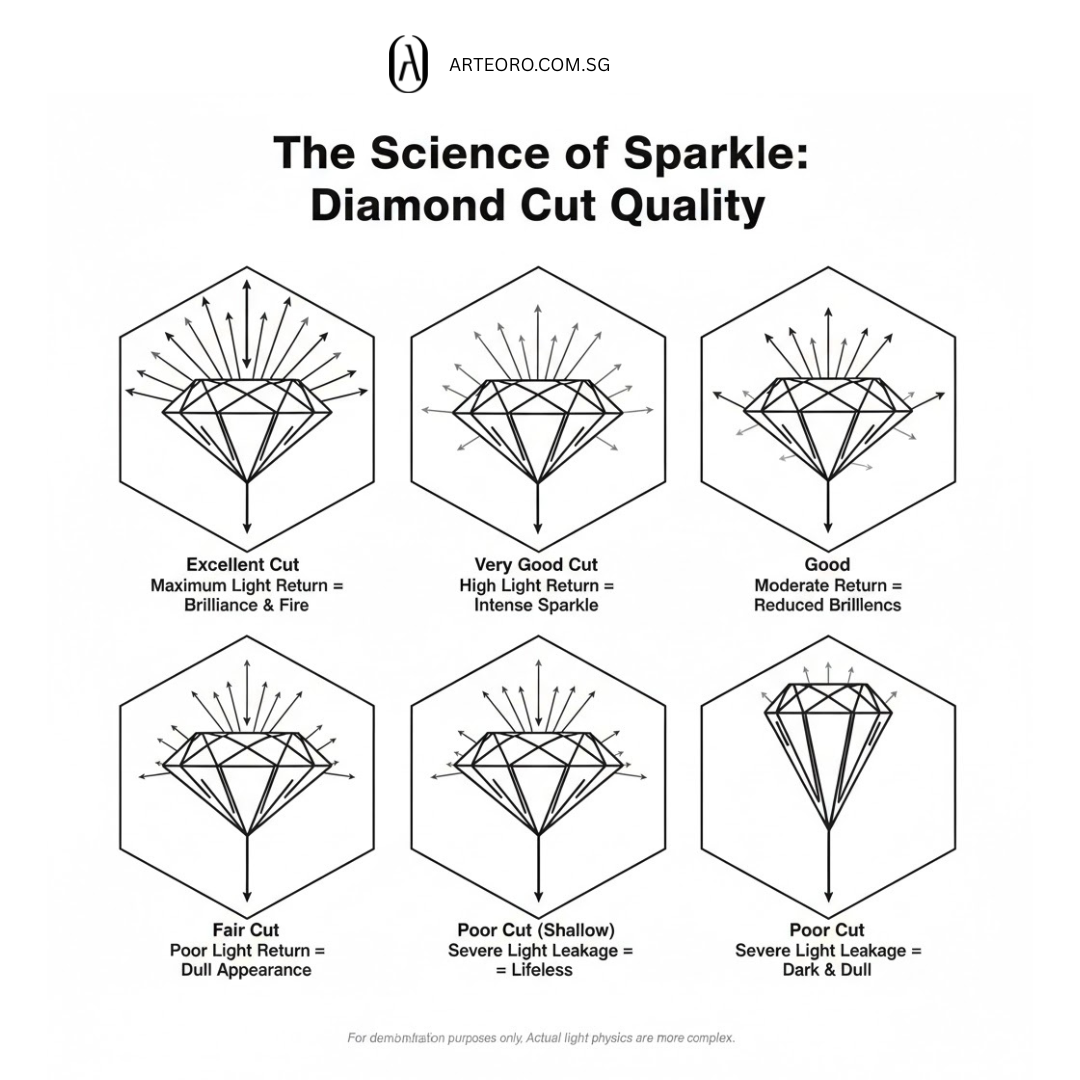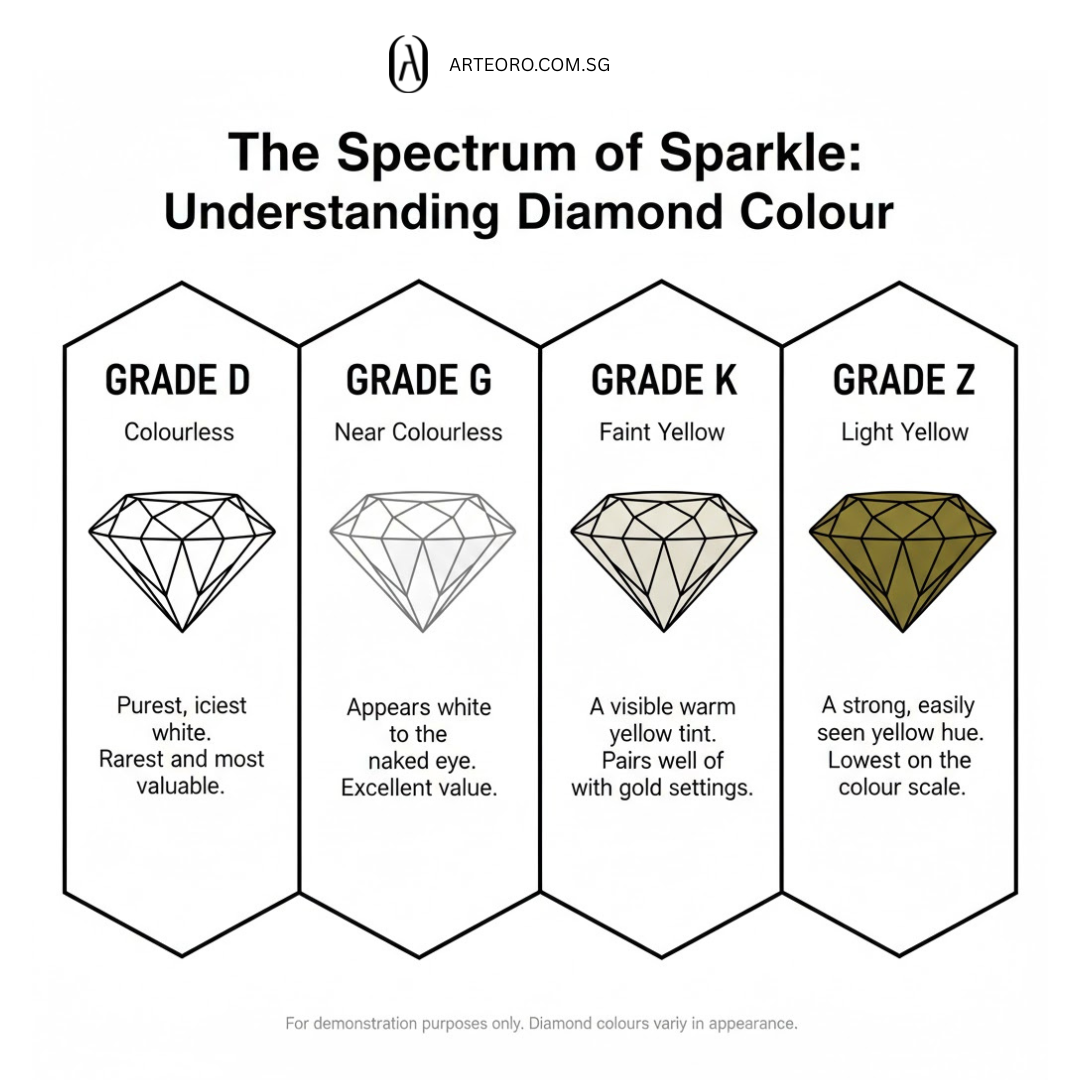The 4 Cs Explained: A Beginner's Guide to Diamond Grading
The process of buying diamonds brings excitement to your life but it requires learning new terminology. The 4 Cs system developed by the Gemological Institute of America (GIA) enables you to shop confidently because it provides a standard evaluation method that all jewelers and grading facilities worldwide use.
The Gemological Institute of America (GIA) created this evaluation system which serves as a worldwide standard for diamond assessment. The 4Cs establish how diamonds should be evaluated for their quality and their market value. The knowledge of these four characteristics enables you to make smart decisions about your priorities and spending limits when searching for your ideal diamond.
1. Cut: The Sparkle Factor (Why it's King)
The Cut stands as the primary factor which determines how beautiful a diamond appears to the human eye. The stone receives light through its structure before the light returns to your eyes as sparkling reflections.
The quality assessment of a diamond depends on its proportions and symmetry and its polished finish. A diamond cut at its best functions as an ideal reflective surface which optimizes light reflection for maximum brilliance. A diamond with perfect Colour and Clarity will appear dull because its poor cut design lets light escape from the bottom of the stone.
The GIA grading system rates Cut quality from Excellent down to Poor.
The stone reflects most light while providing outstanding sparkle at a price point that offers better value than Excellent grades.
The distinction between Cut and Shape exists because people tend to mix them up. The stone's external design pattern determines its shape while cut refers to the precise workmanship which creates brilliance. The outline of a diamond determines its shape but the Cut refers to its technical craftsmanship.
When purchasing a diamond always make Cut your top priority. We suggest selecting diamonds with Very Good or Excellent Cut grades because they provide the best visual effect. The best way to achieve maximum visual impact is by allocating your budget to increase the Cut grade while accepting lower Colour and Clarity ratings.
2. Colour: The Measure of Whiteness
The term Colour in white diamonds describes the absence of any visible colour. The rarest white diamonds achieve perfect colourlessness because they allow complete light transmission which produces exceptional sparkle.
The grading process for Colour assesses the tiny yellow or brown tints which appear when the diamond faces downwards against a pure white background under specific lighting conditions.
The GIA uses a grading system that starts at D for Colourless and ends at Z for Light Yellow or Brown.
D–F: Colourless (Top tier, virtually no visible colour).
The G-J range includes diamonds that appear colourless when set in jewelry while providing excellent value for money. The G-J range provides the most affordable option for diamond buyers.
K–M: Faint Yellow (A slight tint is typically visible).
The colour grade of a diamond becomes less noticeable after it receives a jewelry setting. The appearance of diamonds in the G, H or I range appear white when set in white gold or platinum. When using yellow or rose gold settings you can select stones with J or K colour grades because the warm metal tones will hide the colour while saving you money.
3. Clarity: A Diamond's Natural Fingerprint
The Clarity grade evaluates the level of purity found in diamonds. Natural diamonds which form deep inside Earth's crust usually contain small internal flaws known as inclusions and external imperfections called blemishes.
The evaluation process for Clarity examines the total number and size of characteristics along with their position and relief and natural type under a 10x jeweler's magnification.
The GIA grading system uses an 11-point scale which starts at FL (Flawless) and ends at I3 (Included).
FL / IF: Flawless / Internally Flawless (No visible characteristics under 10x magnification).
The VVS1 and VVS2 grades represent diamonds which have Very Very Slightly Included inclusions that require exceptional expertise to detect under magnification.
The VS1 and VS2 grades represent diamonds with Very Slightly Included inclusions which are barely noticeable to the human eye.
The SI1 and SI2 grades show inclusions that become visible under 10x magnification although most stones in this range appear clear to the naked eye.The price you pay for clarity should not exceed what you can actually see in the stone. We suggest choosing diamonds with VS2 or SI1 grades because they offer excellent clarity while keeping costs affordable. Moving to lower grades will damage the diamond's appearance yet higher grades will cost much more without delivering any noticeable improvement.
4. Carat Weight: The Diamond's Measurement
Carat serves as the standard unit for measuring diamond weight measurement.
What it is: Weight, not size. A single metric carat equals 200 milligrams which represents one-fifth of a gram.
The Cut grade determines how big a diamond appears to be even though heavier stones tend to be larger. A diamond cut at a shallow angle produces a larger diameter but reduced brilliance while a deep cut diamond maintains better Cut grade but shows smaller diameter.
The price of diamonds experiences major increases when they reach specific weight thresholds at 0.50 carats and 1.00 carats and 1.50 carats and so on.
Buyers should consider purchasing diamonds that weigh slightly below the magic numbers (0.90 carats instead of 1.00 carats). The minimal size difference between these stones remains imperceptible to human vision yet you can save enough money to purchase a diamond with a superior Cut grade.
Conclusion: Making the 4 Cs Work for You
The 4 Cs are not a test you have to ace, but rather tools to help you craft the perfect piece of jewellery. Every decision is a trade-off, and the best diamond for you is the one that best balances these four characteristics to meet your personal preferences and budget.
Ready to see the 4 Cs in action?
Schedule a consultation with our GIA-trained experts to view diamonds side-by-side and find your perfect balance of brilliance and value.



